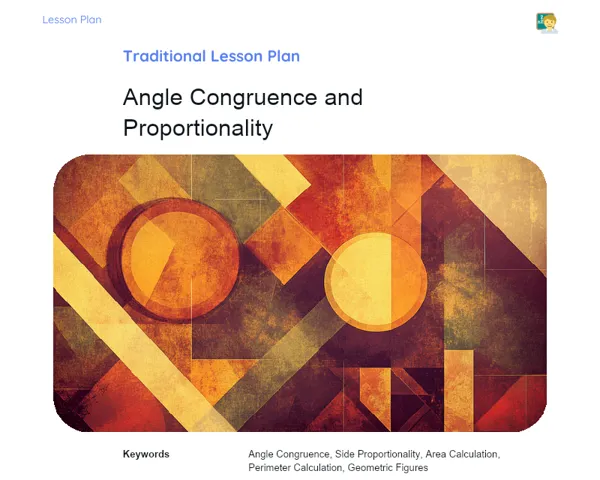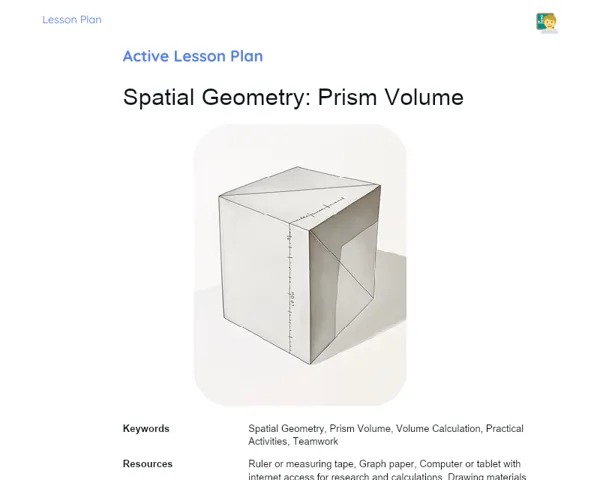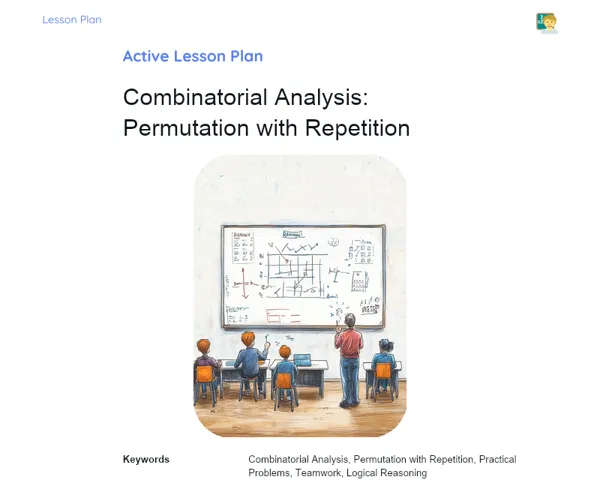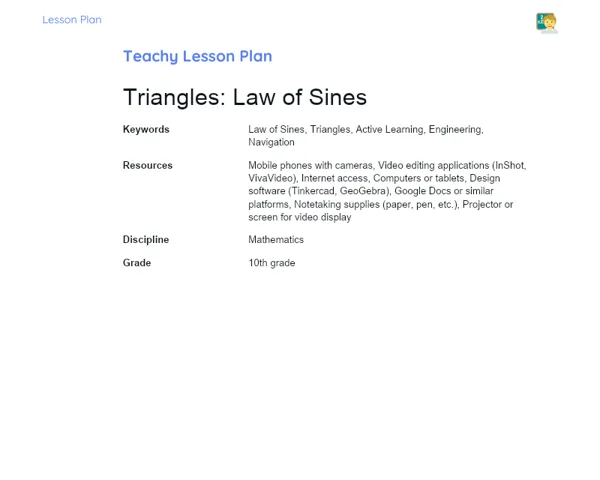Lesson Plan | Lesson Plan Tradisional | Triangles: Menelaus' Theorem
| Keywords | Menelaus theorem, Triangles, Geometry, Segments, Segment relationships, Proof of the theorem, Practical application, Problem solving, Active participation, Class discussion |
| Resources | Whiteboard and markers, Multimedia projector, Presentation slides, Notebooks and pens for note-taking, Geometry textbook, Worksheet for exercises, Ruler and compass, Scientific calculator, Whiteboard or flip chart, Eraser |
Objectives
Duration: 10 to 15 minutes
This stage aims to give a comprehensive overview of the lesson content. It sets clear expectations for students and prepares them for the material ahead, ensuring they recognize the significance of the Menelaus theorem in geometric calculations involving triangles.
Objectives Utama:
1. Introduce the Menelaus theorem and its relevance to triangles.
2. Teach students how to calculate ratios between segments using the Menelaus theorem.
3. Provide practical examples to enhance the understanding of the theorem.
Introduction
Duration: 10 to 15 minutes
This stage aims to provide an overview that sets the context for the lesson, ensuring students grasp the significance of the Menelaus theorem and its applicability in geometric calculations.
Did you know?
Did you know that the Menelaus theorem has been around for over two thousand years and derives its name from the Greek mathematician Menelaus of Alexandria? It has a wide range of uses, including in astronomy, to determine the positioning of stars and planets based on celestial observations that form triangles.
Contextualization
To kick off the lesson on the Menelaus Theorem, it’s important to frame the topic within the study of triangles. Explain that the Menelaus theorem is a vital concept in geometry that relates to the properties of triangles. This theorem deals with a transversal line intersecting the sides (or their extensions) of a triangle, forming a relationship among the intercepted segments. This understanding is essential for tackling complex geometry problems and finds applications in fields like civil engineering, architecture, and physics.
Concepts
Duration: 60 to 70 minutes
This stage aims to deepen students' comprehension of the Menelaus theorem by providing a thorough and practical approach. It is crucial for students to understand both the theoretical aspects and practical applications, allowing them to practice and solidify their knowledge through guided examples and real-world problems.
Relevant Topics
1. Introduction to the Menelaus Theorem: Define the theorem formally. It states that for a triangle ABC and a transversal line intersecting the sides at points D, E, and F, the segments relate as (AF/FB) * (BD/DC) * (CE/EA) = 1.
2. Demonstration of the Menelaus Theorem: Present a proof using a step-by-step approach, starting with drawing the triangle and transversal line, then illustrating how to derive the relationship between the segments.
3. Applications of the Menelaus Theorem: Show practical uses of the theorem through problem-solving. For example, present a scenario requiring the ratio between segments of a triangle cut by a transversal line and provide a detailed solution.
4. Practical Example: Offer a specific problem to resolve during class. For instance, with triangle ABC and points D, E, F on its sides, calculate the segments' ratios using the theorem. Ensure each solution step is clearly explained.
5. Guided Problem Solving: Provide students with a set of problems to solve in class. Guide them through the solutions while addressing their questions and encouraging participation and discussion.
To Reinforce Learning
1. Given triangle ABC with a transversal line crossing its sides at points D, E, and F, prove that (AF/FB) * (BD/DC) * (CE/EA) = 1.
2. In triangle ABC, if the transversal line intersects at points D, E, and F and we have AF = 3 cm, FB = 2 cm, BD = 4 cm, and DC = 1 cm, calculate CE and EA, given CE/EA = x.
3. Using the Menelaus theorem, derive the relationship between segments in a triangle where a transversal line intersects at D, E, and F, with AF = 6 cm, FB = 3 cm, BD = 2 cm, and DC = 4 cm.
Feedback
Duration: 10 to 15 minutes
This stage is designed to review and reinforce students' understanding of the Menelaus theorem, ensuring all doubts are addressed and that students feel confident applying the theorem. It also encourages discussion and reflection, promoting active participation and critical thinking.
Diskusi Concepts
1. Question 1: Given triangle ABC with a transversal line crossing at points D, E, and F, prove that (AF/FB) * (BD/DC) * (CE/EA) = 1.
Explanation: To address this question, start by sketching triangle ABC and label points D, E, and F on sides BC, CA, and AB. Apply the Menelaus theorem, which states (AF/FB) * (BD/DC) * (CE/EA) = 1. Use triangle similarities and segment properties to verify the equality step by step. 2. Question 2: In triangle ABC, if the transversal intersects at points D, E, and F with AF = 3 cm, FB = 2 cm, BD = 4 cm, and DC = 1 cm, calculate CE and EA, knowing CE/EA = x.
Explanation: Start by establishing the equation (AF/FB) * (BD/DC) * (CE/EA) = 1. Substitute the values: (3/2) * (4/1) * (CE/EA) = 1. Simplifying gives (3/2) * 4 * (CE/EA) = 1, resulting in 6 * (CE/EA) = 1, and ultimately (CE/EA) = 1/6, meaning CE to EA is in the ratio 1:6. 3. Question 3: Using the Menelaus theorem, determine the relationship between segments in a triangle where a transversal cuts at points D, E, and F, given AF = 6 cm, FB = 3 cm, BD = 2 cm, and DC = 4 cm.
Explanation: Directly apply the theorem: (AF/FB) * (BD/DC) * (CE/EA) = 1. Substitute the values: (6/3) * (2/4) * (CE/EA) = 1. This simplifies to 2 * 1/2 * (CE/EA) = 1, leading to (CE/EA) = 1, indicating CE and EA are equal.
Engaging Students
1. What challenges did you face while applying the Menelaus theorem in the problems? 2. How did understanding triangle similarities assist in solving the problems? 3. Can you think of any real-life situations where the Menelaus theorem might be useful? 4. If you had to explain the Menelaus theorem to a friend, what would your approach be? 5. What are key steps to follow when solving a problem using the Menelaus theorem?
Conclusion
Duration: 10 to 15 minutes
This segment aims to recap and solidify the key points from the lesson, ensuring that students have an integrated understanding of the Menelaus theorem. Moreover, it relates theory to practice and reinforces the studied content's importance, preparing students for future applications.
Summary
['Formal definition of the Menelaus theorem.', 'Step-by-step demonstration of the Menelaus theorem.', 'Practical application of the Menelaus theorem in solving geometric problems.', 'Guided problem-solving sessions using the Menelaus theorem.', 'Discussion and clarification of doubts regarding the Menelaus theorem.']
Connection
The lesson effectively bridged the theoretical aspect of the Menelaus theorem with practical applications by showing how to calculate the ratios of segments in triangles intersected by a transversal line. Real-life examples and guided problem-solving allowed students to solidify their theoretical understanding through applicable scenarios.
Theme Relevance
The Menelaus theorem is crucial for grasping geometric properties in triangles, applicable in various fields like civil construction and astronomy. Mastering its use equips learners to tackle complex problems involving segment relationships, demonstrating its practical significance across everyday situations and professions.



